|
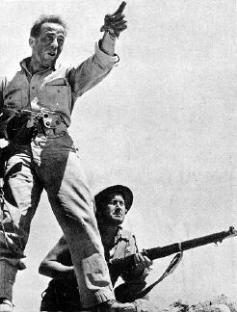 From the fall of
France in June 1940 to the battle of Midway in June 1942, the Axis forces were winning World War II. Paris occupied, London bombed,
Stalingrad under siege, Pearl Harbor sneak attacked... the Allies were losing the War. Hollywood responded with some of the most
political, most inspirational, and most dark films ever made. From the fall of
France in June 1940 to the battle of Midway in June 1942, the Axis forces were winning World War II. Paris occupied, London bombed,
Stalingrad under siege, Pearl Harbor sneak attacked... the Allies were losing the War. Hollywood responded with some of the most
political, most inspirational, and most dark films ever made.
From A-list movies like So Proudly We Hail with Claudette Colbert and an impressively psychotic
Veronica Lake, or Humphrey Bogart and Ingrid Bergman in
Casablanca, to B-movies like Secret Agent of Japan with
Lynn Bari, or even
Tarzan Triumphs, Hollywood set out to not just win the War,
but turn the tide of the War.
British films like Michael Powell and Emeric Pressburger's
49th Parallel and One of Our Aircraft is Missing, or Carol Reed's
Night Train to Munich also faced the challenge of
making cinema about losing that sought to motivate the viewers into winners. The styles, tricks, themes and motivational devices in
these films came in many forms. Audience's heads, hearts and groins all were appealed to. Here are ten of the best of the lesser-known
"losing the war" films that did in fact do their part (and in some cases much more) in winning the War.
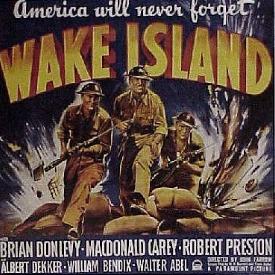 1) Wake Island, 1942.
For the United States, Wake Island was the Alamo of World War II. The first American war movie released after Pearl Harbor, Wake Island
tells the story of the 1500 Marines and civilians who held the postage stamp-sized island from a Japanese fleet for fifteen days after
Pearl Harbor. While the defenders were hopelessly overmatched, the movie managed to make the odds seem even longer. However, the film's
memorable scene of a single American plane taking off to do battle with a thirty plane Japanese squadron is surprisingly accurate. 1) Wake Island, 1942.
For the United States, Wake Island was the Alamo of World War II. The first American war movie released after Pearl Harbor, Wake Island
tells the story of the 1500 Marines and civilians who held the postage stamp-sized island from a Japanese fleet for fifteen days after
Pearl Harbor. While the defenders were hopelessly overmatched, the movie managed to make the odds seem even longer. However, the film's
memorable scene of a single American plane taking off to do battle with a thirty plane Japanese squadron is surprisingly accurate.
Far less accurate was the vivid image the film sent of the Wake defenders fighting, like at the Alamo,down to the last defiant man. In reality there were 129 American causalities
(several hundred Japanese were also killed), the rest became prisoners of war. Ninety-eight of these prisoners were civilian contractors
who were left on Wake to continue
their work there. All of these men were executed in 1943 by the Japanese after a US attack on the island.
Wake Island was the template for morale-boosting movies of the early days of the war. Unlike the Philippines defeat, which dragged on for months,
Wake Island portrayed a near-perfect historical event, from a propaganda perspective. Like the Alamo a hundred years before, Wake was a brief
but not-too-brief flash of heroism and defiance that lent itself to a now-we-are-pissed-off mood that the American people preferred over the sorrow
associated with Pearl Harbor. Many patriotic films followed, making a greater impact on the public psyche, but Wake Island was the first,
and it did the job admirably, just like the Wake Marines.
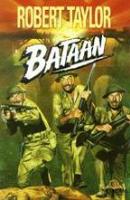 2) Bataan, 1943. Bataan
deals with the key American surrender of the War. In fact, it deals with the key American surrender in any war, the most significant defeat in
American history with the exception of the burning of Washington in the War of 1812. From the first scene, this movie reeks of defeat,
with a blinded, retreating soldier dying a horrible death in an air raid. To a large degree this movie consists of a series of scenes of men
dying in increasingly brutal, hand-to-hand ways. Robert Walker is pretty bad but Lloyd Nolan is pretty great. Upon discovering one of the
dozens of supposedly dead Japanese in front of them is still alive, Nolan cocks his Tommy-gun and says: "One way to find out... spray
the batch of them." 2) Bataan, 1943. Bataan
deals with the key American surrender of the War. In fact, it deals with the key American surrender in any war, the most significant defeat in
American history with the exception of the burning of Washington in the War of 1812. From the first scene, this movie reeks of defeat,
with a blinded, retreating soldier dying a horrible death in an air raid. To a large degree this movie consists of a series of scenes of men
dying in increasingly brutal, hand-to-hand ways. Robert Walker is pretty bad but Lloyd Nolan is pretty great. Upon discovering one of the
dozens of supposedly dead Japanese in front of them is still alive, Nolan cocks his Tommy-gun and says: "One way to find out... spray
the batch of them."
The justly famous final scene succeeded in inspiring and angering American moviegoers like Grade A propaganda should. Exhausted and now alone,
all his comrades dead, Robert Taylor stands in the grave he has dug for himself, maniacally firing at and cursing at the Japanese soldiers who
are seconds from killing him. Wake Island dealt with the heroism in the inevitable loss to an hugely outnumbered force. Bataan
is about anger, rage and defeat, and an almost psychotic desire for revenge.
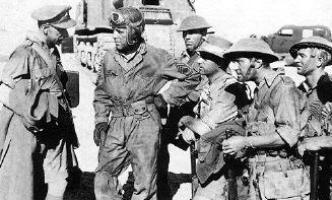 3) Sahara, 1943. The focus here is
the fall of Tobruk and the aftermath, the last really significant Allied loss of the War. A straggling American tank crew retreating ("we're
not running away") into the desert picks up a motley crew Allied soldiers (French, British, South African, Sudanese) and two prisoners
-- an evil Nazi and not-bad Italian. They drag themselves from dry waterhole to dry waterhole. When they finally find a small amount of water,
the nine decide to stand and fight a waterless battalion of 500 Germans. The Lost Patrol meets the Alamo. 3) Sahara, 1943. The focus here is
the fall of Tobruk and the aftermath, the last really significant Allied loss of the War. A straggling American tank crew retreating ("we're
not running away") into the desert picks up a motley crew Allied soldiers (French, British, South African, Sudanese) and two prisoners
-- an evil Nazi and not-bad Italian. They drag themselves from dry waterhole to dry waterhole. When they finally find a small amount of water,
the nine decide to stand and fight a waterless battalion of 500 Germans. The Lost Patrol meets the Alamo.
Nominated for three Academy Awards, Sahara was directed by Zoltan Korda and written by John Howard Lawson, who was later blacklisted. Humphrey Bogart stars.
One great scene features a fight where a man literally drowns in sand. The most memorable scene is the Sudanese and the Texan discussing the proper number
of wives a man should have, and why.
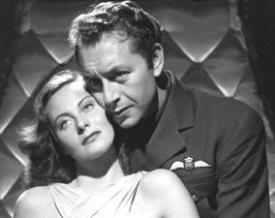 4) Joan of Paris, 1942.
Filmed before Pearl Harbor, Joan of Paris has naively optimistic ideas about an invasion of Europe, but it holds a key place in World War II
filmmaking. The Battle of Britain over, eyes turn back across the English channel. One way or another Great Britain and the Free French would
retake continental Europe. Eventually the lights would come back on, no matter how unlikely that seemed. But it would take endless sacrifice,
like that of the titular barmaid here. Joan, naturally named after Joan of Arc, gives her life for the man she loves, so he can return to England,
so he can return once again to France as a liberator. 4) Joan of Paris, 1942.
Filmed before Pearl Harbor, Joan of Paris has naively optimistic ideas about an invasion of Europe, but it holds a key place in World War II
filmmaking. The Battle of Britain over, eyes turn back across the English channel. One way or another Great Britain and the Free French would
retake continental Europe. Eventually the lights would come back on, no matter how unlikely that seemed. But it would take endless sacrifice,
like that of the titular barmaid here. Joan, naturally named after Joan of Arc, gives her life for the man she loves, so he can return to England,
so he can return once again to France as a liberator.
Gloom, bitterness and death are everywhere here. In his last non-starring role,
Alan Ladd plays "Baby", just about the only happy person
in this movie. Of course he is doomed. Innocence dies. Even in a schoolhouse scene, after two boys fight over what is the capital of France, Paris
or Vichy, the children sing La Marseilles as the Germans fire rifles at their fleeing elderly schoolteacher. Innocence is way dead.
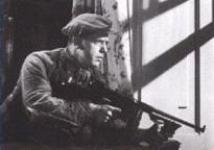 5) Went The Day Well, 1942.
Went The Day Well is an outstanding, little-known British film detailing an account of a German paratroop company's takeover of a tiny English village
in advance of an invasion of England set for two days later -- and the response of the villagers once they discover the identity of Germans. 5) Went The Day Well, 1942.
Went The Day Well is an outstanding, little-known British film detailing an account of a German paratroop company's takeover of a tiny English village
in advance of an invasion of England set for two days later -- and the response of the villagers once they discover the identity of Germans.
Dressed as British troops, the paratroopers arrive under the pretense of doing maneuvers in the out of the way hamlet. Instantly distrustable Leslie Banks plays a local official who is actually a quisling. The great disrespect with which the Germans treat this collaborator
is interesting in itself, but without a doubt what truly sets this film apart is the utter brutality of the villagers when they get their chance.
Vicious beatings, one truly memorable hatchet killing, and the deliberate, cold-blooded murder of the quisling by a young woman... brrrr. Hard
to find, but while Joan of Paris well defines the gloom of occupied France, Went The Day Well shows genteel, polite, "normal"
Brits completely ready to show no mercy whatsoever on the Nazis.
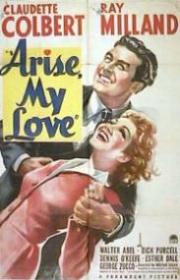 6) Arise, My Love, 1940. Written
by Billy Wilder and Charles Brackett, Arise, My Love is a political manifesto masquerading as a love story. Seeking a juicy story,
newswoman Claudette Colbert rescues American flyer Ray Milland by posing as his wife just before he is about to be executed in a Spanish
prison after the Spanish Civil War -- the "palooka preliminaries" of the fight against fascism. Their ensuing romance is merely
a cover for a two hour appeal to the American public to abandon isolationism and join the fight against dictatorship. 6) Arise, My Love, 1940. Written
by Billy Wilder and Charles Brackett, Arise, My Love is a political manifesto masquerading as a love story. Seeking a juicy story,
newswoman Claudette Colbert rescues American flyer Ray Milland by posing as his wife just before he is about to be executed in a Spanish
prison after the Spanish Civil War -- the "palooka preliminaries" of the fight against fascism. Their ensuing romance is merely
a cover for a two hour appeal to the American public to abandon isolationism and join the fight against dictatorship.
The title comes from the Song of Solomon ("Arise, my love, my fair one, and come away") and is first applied to an airplane as they flee Spain,
then to their romance, and then explicitly directed at the American audience. Wilder and Brackett work very hard to use the romance to make the politics
of the film go down easily. Milland and Colbert are very good, as is Walter Abel and his signature line: "I'm not happy. I'm not happy
at all." Several other American movies from 1940 were also among the most directly political films Hollywood has ever made:
Foreign Correspondent, The Mortal Storm, Escape, and The Great Dictator. With Arise My Love though,
Hollywood sent the message that fighting fascism is not just the right thing to do, but you get the girl to boot!
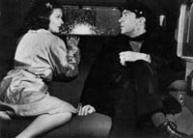 7) Man Hunt, 1941. Man Hunt has
a similar agenda to Arise, My Love, and a similar love story. The appeal to America here though is darker, presumably due to being
directed by German expatriate Fritz Lang. Walter Pidgeon (star of one of the key films of the era, Mrs. Miniver) stars as a big game hunter
for whom regular hunting is no longer a challenge, so he challenges himself to a "sporting stalk" of Adolf Hitler during the summer
of 1939. Sneaking up on Hitler's mountain estate, Pidgeon gets Hitler in his rifle sites... and pulls the trigger. But the gun isn't loaded.
The "sport" was merely in seeing if he could do it. As Pidgeon starts to crawl away, he pauses and thinks again, and now he crawls
back to where he can take a shot... and puts a bullet in the chamber! 7) Man Hunt, 1941. Man Hunt has
a similar agenda to Arise, My Love, and a similar love story. The appeal to America here though is darker, presumably due to being
directed by German expatriate Fritz Lang. Walter Pidgeon (star of one of the key films of the era, Mrs. Miniver) stars as a big game hunter
for whom regular hunting is no longer a challenge, so he challenges himself to a "sporting stalk" of Adolf Hitler during the summer
of 1939. Sneaking up on Hitler's mountain estate, Pidgeon gets Hitler in his rifle sites... and pulls the trigger. But the gun isn't loaded.
The "sport" was merely in seeing if he could do it. As Pidgeon starts to crawl away, he pauses and thinks again, and now he crawls
back to where he can take a shot... and puts a bullet in the chamber!
As he takes aim again, a sentry jumps him. For the rest of the movie
heel-of-all-heels George Sanders chases Pidgeon to try to get him to sign a statement that Great Britain sent him to kill Hitler. Along the way,
Pidgeon not only doesn't get the girl, but she dies an awful death, after refusing to talk under torture. The one year difference between
Arise, My Love and Man Hunt resulted in a cavernous difference in appeal. Romance and justice give way to darkness and disgust.
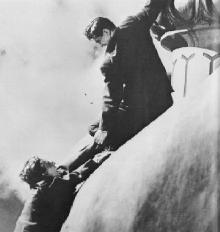 9) Saboteur, 1942. Despite the
historical fact that there was hardly any German sabotage inflicted on America before or during the War, it was a popular theme to "bring the
war home". Confessions of a Nazi Spy in 1939 showed the FBI trying to catch up in the espionage business, with thousands of German spies
apparently at work in the USA. Nazi Agent is the story of a mild-mannered German-American stamp dealer who kills his German diplomat twin
brother and sets out to destroy the Nazi spy ring that was under his brother's control. All Through The Night has Humphrey Bogart leading
his double-talking gambling buddies against a fifth column of Nazis in New York: "About time somebody knocked these heels back on their Axis." 9) Saboteur, 1942. Despite the
historical fact that there was hardly any German sabotage inflicted on America before or during the War, it was a popular theme to "bring the
war home". Confessions of a Nazi Spy in 1939 showed the FBI trying to catch up in the espionage business, with thousands of German spies
apparently at work in the USA. Nazi Agent is the story of a mild-mannered German-American stamp dealer who kills his German diplomat twin
brother and sets out to destroy the Nazi spy ring that was under his brother's control. All Through The Night has Humphrey Bogart leading
his double-talking gambling buddies against a fifth column of Nazis in New York: "About time somebody knocked these heels back on their Axis."
Alfred Hitchcock's Saboteur is primarily remembered for its justly famous final Statue of Liberty scene, but at the time it succeeded in
taking spies and sabotage literally all over the country. Hitchcock's innocent man is desperate and alone and unable to trust anyone, even in America.
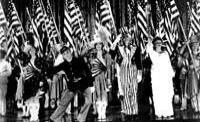 10) Yankee Doodle Dandy,
1942. Not suspense or action filmmaking, but one of the most important war films of the era. You can imagine audiences marching out of the theater with
James Cagney, ready to kick fascist butt, singing George M. Cohan's "Over There": "Send the word, send the word, over there!/That the
Yanks are coming, the Yanks are coming.../We'll be over, we're coming over/And we won't come back 'til it's over Over There!" War movies are not
just about war. They are about preparing people's psyches to wage war. 10) Yankee Doodle Dandy,
1942. Not suspense or action filmmaking, but one of the most important war films of the era. You can imagine audiences marching out of the theater with
James Cagney, ready to kick fascist butt, singing George M. Cohan's "Over There": "Send the word, send the word, over there!/That the
Yanks are coming, the Yanks are coming.../We'll be over, we're coming over/And we won't come back 'til it's over Over There!" War movies are not
just about war. They are about preparing people's psyches to wage war.
11) Desperate Journey, 1942. Bonus pick, good Raoul Walsh action film but most notable for Ronald Reagan double-talking a nasty Nazi!
|